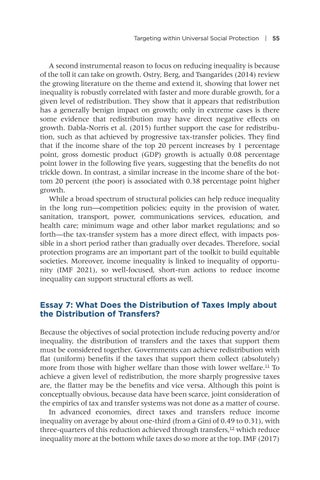Targeting within Universal Social Protection | 55
A second instrumental reason to focus on reducing inequality is because of the toll it can take on growth. Ostry, Berg, and Tsangarides (2014) review the growing literature on the theme and extend it, showing that lower net inequality is robustly correlated with faster and more durable growth, for a given level of redistribution. They show that it appears that redistribution has a generally benign impact on growth; only in extreme cases is there some evidence that redistribution may have direct negative effects on growth. Dabla-Norris et al. (2015) further support the case for redistribution, such as that achieved by progressive tax-transfer policies. They find that if the income share of the top 20 percent increases by 1 percentage point, gross domestic product (GDP) growth is actually 0.08 percentage point lower in the following five years, suggesting that the benefits do not trickle down. In contrast, a similar increase in the income share of the bottom 20 percent (the poor) is associated with 0.38 percentage point higher growth. While a broad spectrum of structural policies can help reduce inequality in the long run—competition policies; equity in the provision of water, sanitation, transport, power, communications services, education, and health care; minimum wage and other labor market regulations; and so forth—the tax-transfer system has a more direct effect, with impacts possible in a short period rather than gradually over decades. Therefore, social protection programs are an important part of the toolkit to build equitable societies. Moreover, income inequality is linked to inequality of opportunity (IMF 2021), so well-focused, short-run actions to reduce income inequality can support structural efforts as well.
Essay 7: What Does the Distribution of Taxes Imply about the Distribution of Transfers? Because the objectives of social protection include reducing poverty and/or inequality, the distribution of transfers and the taxes that support them must be considered together. Governments can achieve redistribution with flat (uniform) benefits if the taxes that support them collect (absolutely) more from those with higher welfare than those with lower welfare.11 To achieve a given level of redistribution, the more sharply progressive taxes are, the flatter may be the benefits and vice versa. Although this point is conceptually obvious, because data have been scarce, joint consideration of the empirics of tax and transfer systems was not done as a matter of course. In advanced economies, direct taxes and transfers reduce income inequality on average by about one-third (from a Gini of 0.49 to 0.31), with three-quarters of this reduction achieved through transfers,12 which reduce inequality more at the bottom while taxes do so more at the top. IMF (2017)


